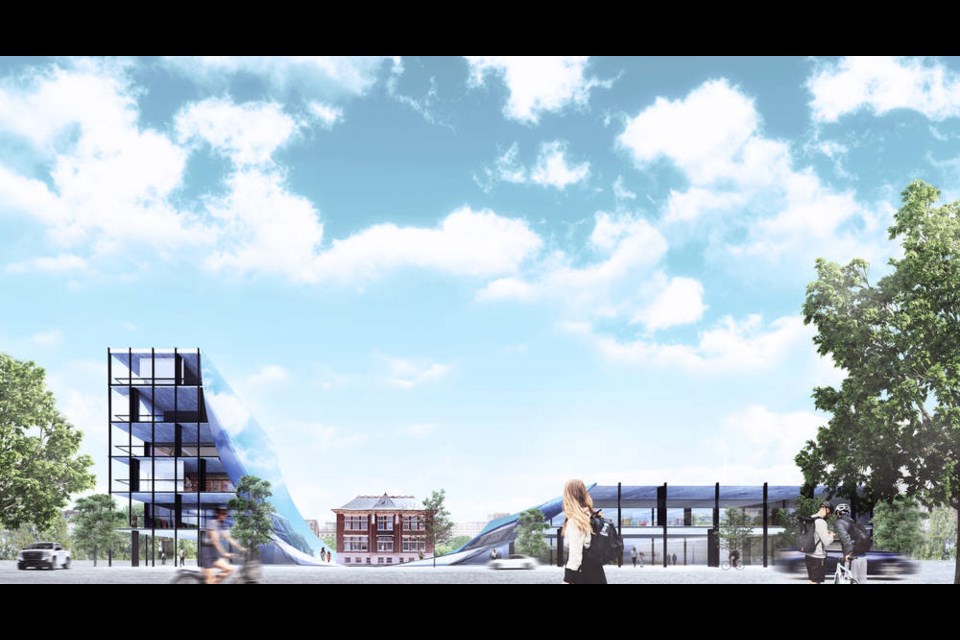A commentary by a partner in Aryze Developments, who leads its land acquisition and development efforts.
Let’s try this again. The last time we wrote an article about the outsized role of architectural heritage in Victoria — in relation to the Northern Junk buildings — it invoked the same reaction as being one car short of getting on the ferry.
City building isn’t just about built form, it is a dialogue expressed in critique and incrementalism. That’s why every time this debate resurfaces, it is imperative we seize the opportunity to facilitate a conversation around what Victoria means to us and what it could mean to somebody else.
That is the only way to create a Victoria that we can all identify with. The next opportunity has arrived, so let’s rise to the occasion and think diligently about how we want to shape our city.
As many are probably aware, due to climbing enrolment and demographic shifts within School District 61, the former Bank Street School in South Jubilee is the subject of some high-level discussions with regards to its future: Either as a part of a new elementary school, combined with École Beausoleil next door, or as a target for demolition in order to allow for an expansion of the newer building, formerly known as Sundance.
This debate is familiar in Victoria, as it mirrors the brouhaha around the Vic High building: do we demolish and rebuild, or refurbish and renovate to preserve what we have even though the costs are higher?
In most cases, the answer to this question comes down to deeply held values, community priorities, and, yes, architectural history.
The building in question ticks all the regular boxes after all: Built 1910-11 to a design by architect D.C. Frame, known for his work on the Empress with Francis Rattenbury as well as the Chinese Public School on Fisgard.
However, we must begin to acknowledge it is not the form, the original use, or even the name recognition of the building that determines its potential as a worthwhile project.
We must consider a core principle too often overlooked in the wider conversation around how, why, and when we choose to keep older buildings, often at great expense.
What kind of afterlife will these buildings have? What role will they play in their community? If we are to consider these principles, should we not prioritize the retention of buildings that will figure prominently in the lives of many current and future generations of Victorians?
The answers to these questions would put the adaptive re-use of the Bank Street Schoolhouse on an entirely different plane than the likes of the Northern Junk buildings; all of which is to say we need to keep these conversations in their rightful place and not simply lump heritage into a monolith, graded only by date of construction and forgetting past, present, and future contributions to the community.
If these buildings can be incorporated into the urban fabric as a living breathing part of the community, with links to other institutions and diverse groups within the city, then they will be worth saving.
If we fail to consider these core principles, what will happen to other, similar landmark educational and institutional buildings when they come to the end of their useful lives?
Will they also be leased out to molder and collect dust, deferred maintenance piled on deferred maintenance until the tenant leaves behind a “zombie building” too dangerous to use? Or can we come together as a community to realize that in order for heritage to matter it needs to have life, vibrancy.
The beautiful thing about this particular opportunity is that after years of declining enrolments, the conditions required for this school to be useful again have returned; families are once again in the area and children are once again seeking somewhere to learn.
This drives home the fundamental principle that we need neighbourhoods to be for everyone, otherwise how many more Bank Streets will we face losing?
Bank Street School is the North Star in a neighbourhood without one. Fernwood has the Belfry, Fairfield has Cook Street Village, Hillside/Quadra has Quadra Village.
While South Jubilee is a beautiful, diverse neighbourhood with what may be the best secret family park in Victoria, it lacks a strong sense of central gravity to unite residents and visitors. The Bank Street School could be that focal point taking on a life larger than just a building — it is a sense of place and purpose, the springboard for aspiration.
What needs to happen is not just restoration, not just repairs to buy some more time.
This opportunity presents an opening to not only save what we have, but to bring something new to the neighbourhood, something that could connect to the past but also provide room to grow into for the future, and even add some whimsy to what is a very serious old building.
We hope to see bold and interesting proposals for this and many of Victoria’s strangled heritage sites in the near future.



